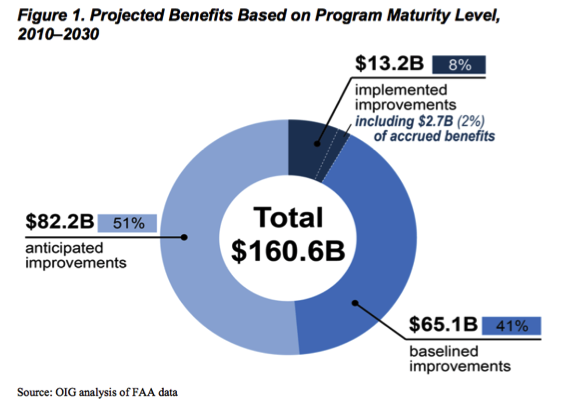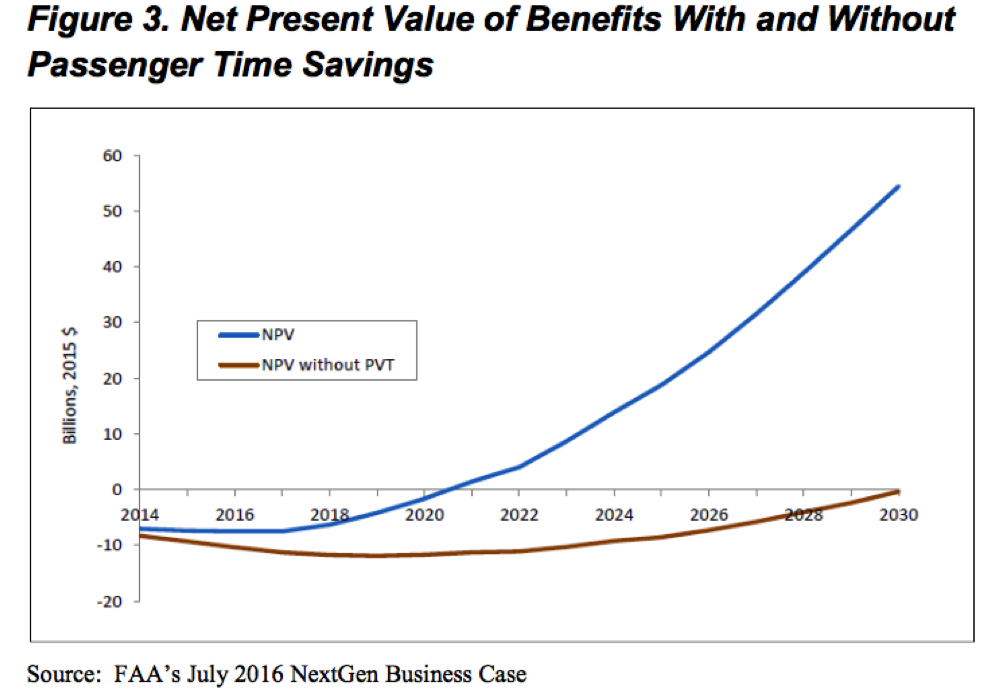September 7, 2017
The Inspector General (IG) at the U.S. Department of Transportation (USDOT) made public this week an August 15 letter with their analysis on the Federal Aviation Administration’s (FAA) most recent business case for NextGen, the agency’s ongoing program to modernize air traffic control (ATC). Overall, the IG found that FAA’s estimate of $161 billion in benefits by 2030 is “overly optimistic”, and that FAA made a number of methodological choices that do not “communicate the range of uncertainty or complex factors associated with NextGen implementation”.
To reach the value of $161 billion of benefits, $2.7 billion of which have already been delivered to users between 2010 and 2016, the FAA estimated the benefits of 64 different operational improvements that NextGen will deliver. However, the IG found that many of those improvements have not even started to be implemented (“anticipated improvements” in Figure 1), and as such the FAA is assuming that all programs will be delivered on time (and on budget)—a bold assumption, given that, on average, NextGen projects are delayed by five years.

On top of that, the FAA used program schedules that were already outdated when the benefits were estimated (the longer a program takes to deliver benefits, the less benefits it will deliver, because benefits in the future have to be discounted). Even for the programs that are already implemented (“implemented improvements”) or underway (“baselined improvements”), the FAA assumed a smoother implementation that as in fact happened in reality (in one of the cases—improvements at Las Vegas airport—the report assumes benefits related to decreased delays, when observations made by the FAA indicate that the new improvements led to an increase in delays).
Another area where the IG is critical is in how much the FAA relies on valuating passengers’ time to get to the $161 billion figure. In fact, two-third of the benefits delivered by NextGen will result by passengers spending less time traveling, either because the system will become more efficient (more direct routes, e.g.) or because delays will be reduced. How does the FAA come up with such a figure? By using USDOTs standard valuation of passenger time: $47.10 per passenger-hour (an average of $36.10 per hour for personal travel and $63.20 per hour for business travel) in 2015 dollars, with 1.6 percent real growth for each subsequent year.
(Ed. Note: At a valuation of $63.20 per hour on a business trip, the cost of the wait time at the Chick-Fil-A at BWI will probably always exceed the price of the delicious chicken sandwich itself.)
On the issue of costs of delays to passengers, Airlines for America recently estimated, using data from U.S. DOT, how much of a cost those delays represented in 2016 for passengers: $1.8 billion. The estimate takes into account 400,000 hours of national aviation system-related delays in 2016, an average of 101 people in each aircraft, and a valuation of passengers’ time of $46 per hour.
This valuation of passenger time assumes such an important role that, if we exclude those benefits, NextGen would in fact result in a negative net present value (a measure of return-on-investment) by 2030, instead of the positive $54 billion that the FAA estimates (see Figure 3 below).

(PVT is the “passenger value of time”.)
Finally, the IG also comments on the lack of alternative outcomes in the FAA’s estimates. For example, the FAA did not study scenarios where certain NextGen programs were delayed, or where air traffic did not grow as much as the baseline predictions (which tend to be consistently optimistic). This sort of sensitivity analysis is recommend by the Office of Management and Budget (OMB) and, according to the IG, failure to perform it implies a level of certainty and confidence that is not warranted.





